This week I’m going to leave Victoria Stevens‘ presentation on her completed MA thesis and the trip to the Canterbury Glass Studio until next week and instead bring you the report produced by Vanessa Sanderson, Jason Mazzocchi and Kieron Hoyle on the Shipbuilding conference at Chatham Dockyard, as well as a couple of photos and a note on the Canterbury Expo. So thanks very much to Kieron, Jason and Vanessa.
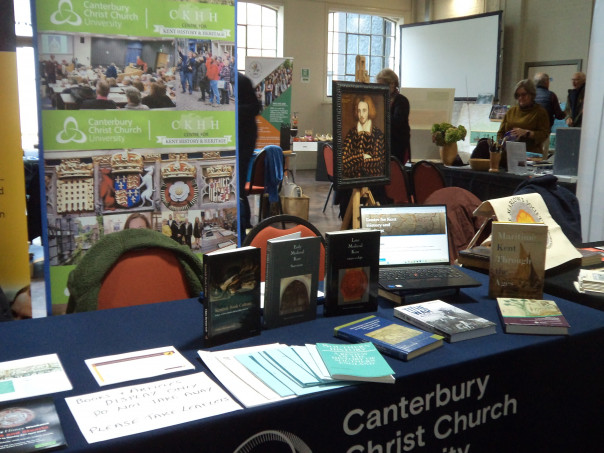
Chatham Dockyard hosted a two-day Kent Shipbuilding conference organised jointly by KAS (Maritime Kent Special Interest Group) and Chatham Historic Dockyard Trust and attracted approximately 80 delegates over the two days. The CEO of Chatham Historic Dockyard Trust, Richard Morsley, started proceedings with a 400-year overview of the historic dockyards in an address of the attendees. Richard stressed the importance of the dockyard on a journey from the late 17th century until it was closed in 1984. He then explained how the dockyard has transformed itself to be a principal attraction to over 130,000 visitors a year.
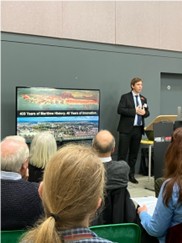
Stuart Bligh introduced the two-day event to the audience and Paul Bennett started session one on Restoration and Replica in discussion of the Dover Bronze Age Boat. The talk focussed on the building of the half-scale replica, from a review of principal components of the boat discovered in 1992 to its launch in 2012 as a working boat and an archaeological experiment. He explained how the replica was designed by Ole Crumlin-Pedersen, a Danish nautical archaeologist, and Richard Darrah, an ancient woodworking specialist and experimental archaeologist from Norfolk. The boat was constructed by a team led by Richard Darrah, while the project was managed by Peter Clark of Canterbury Archaeological Trust. Sadly, all three men have since passed away. This talk was dedicated to their memory.
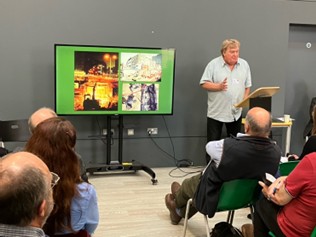
Gordon Vincent gave the next presentation on the history of the oyster yawl and the families which relied upon those vessels. He explained the restoration of the Gamecock and its future as a working boat, a tourist attraction, and a modern community focus helping disadvantaged young people and adults. Gordon established the charity Whitstable Maritime to celebrate the town’s maritime heritage while working to maintain and strengthen the local economy by building on its maritime traditions and crafts.
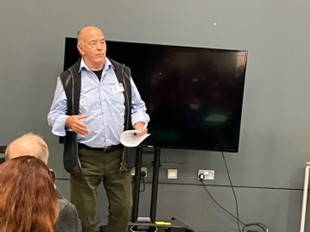
Session two on Ship Archaeology, chaired by Catherine Holt, consisted of a panel of two speakers. First, Peta Knott presented on ‘Uncovering the Mysteries of the Sandwich Bay Wooden Wrecks’. She explained that dispersed across the five-mile beach at Sandwich Bay are the remains of ten unidentified wooden vessels that offer tantalising glimpses into the past for beach walkers at low tide. Since 2018, the Nautical Archaeology Society has been working with beach walkers, residents, NAS members and local stakeholders in a citizen science project to teach maritime archaeology skills. The mission has been to record and monitor the artefacts and shipwrecks at Sandwich Bay before they are lost to the sea. This talk outlined the physical remains recorded on the beach to show the extensive work done so far and potential research avenues for the future. One of these research avenues is using the physical evidence of shipbuilding techniques as a key method of identifying the mystery vessels. Peta invited local experts to comment on and contribute to the identification of these vessels.
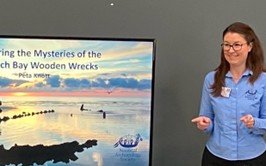
Following this fascinating talk Damian Goodburn presented his ideas on The Graveney Boat. He outlined how the timbers of an ancient clinker-built boat were found in the Graveney marshes near Faversham in September 1970 during the excavation of a drainage channel for the Kent River Authority. Damien explained the oak vessel was 10 metres long, but it is estimated that its full size was over 14 metres long and less than 3 metres broad, with a 7.5 metre keel. The ship was taken to the National Maritime Museum for urgent conservation and stabilisation. This illustrated talk on the late-Saxon period Graveney boat covered its excavation and set the find in historical context with archaeological evidence for other early craft found in the south-east corner of England.
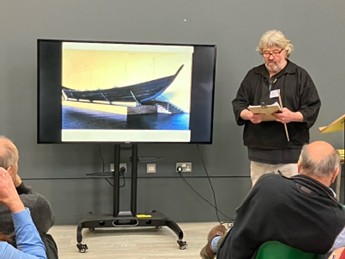
The conference venue provided lunch for the attendees who also had the chance to view and meet exhibitors from the KAS (Maritime Kent Special Interest Group) and the CKHH on Dover and the Maison Dieu and the Faversham Oyster Disputes. There was also the option to have guided tours and walk around the historic dockyard.
The last panel session of the day focussed on Shipbuilders and Social History and was chaired by Kieron Hoyle. Brian Lavery spoke on the Shipwrights of Deptford Dockyard and presented the fact that very little is left of the fabric of the dockyard, but more than a hundred letter books have survived for the period 1690–1815, perhaps the most detailed record of any industrial organisation before the 19th century. The letter books are written by the officers of the yard and give hints to the lives of the workers under them. Brian’s talk looked at the key workers of the yard, the shipwrights, and provided insights into their private and communal lives in the town of Deptford. Several working shipwrights are mentioned including Josias Slade, ‘married to the female shipwright’, and the older men employed in the boathouse and mast house.
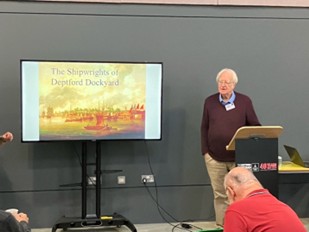
Next, Paul Wright stepped in at the last hour to present his paper on ‘The Significance of Chatham Historic Dockyard Trust’s Small Boats Collection’. Through a collection of images Paul illustrated how the Chatham Historic Dockyard Trust cares for an internationally significant collection of historic vessels, including HMS Cavalier, HMS Gannet and HMS Ocelot. The Trust also has a growing collection of boats and small craft including a number of cutters. Paul provided an overview of the collection at the Dockyard and the unique stories the small boats and craft tell. He is working alongside dedicated collections and heritage professionals, as well as ship keepers, to research the significant collections and develop an interpretation to continuously improve how the story is told of over 400 years of maritime and social history.
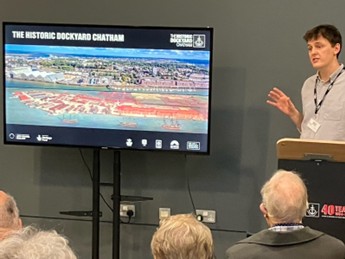
The concluding session on day one was a presentation of the ‘Austins: Shipwrights and Barge Builders’ by Sarah Austin. She presented a family history of three generations of barge builders and shipwrights in Kent. The changing fortunes and evolving practices of a family’s history are explored through documentary evidence, including census returns, trade directories, newspaper articles, photographs, and papers from H. M. Dockyard Chatham. This evidence was placed within a broader social context using extracts from Sarah’s grandfather Len Austin’s Autobiography (1974). Sarah’s interests also include exploring commonplace activities of the past and amplifying the everyday voices, particularly of women and children.
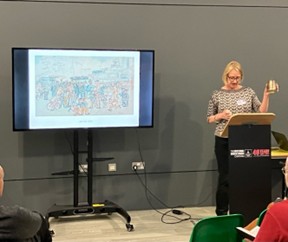
Day two events started well with a panel session on Shipbuilding during Wartime chaired by Martin Crowther. Colin Varrell’s presentation of ‘Shipbuilding at Richborough Port during the First World War’ was a fascinating exploration of this natural land geographic location on the coast of Kent. Richborough’s position became strategically important during the First World War, when the Royal Engineers developed two shipbuilding yards to assemble specially designed cross-Channel barges to meet wartime demands for transporting military equipment to France and Belgium. Between December 1916 and November 1919, those cross-Channel barges carried 1,802612 dead tons of war material.
Colin’s presentation examined Richborough not only for the importance of its location, but also for innovative shipbuilding techniques which were developed there during the First World War.

The second speaker of the session was Henry Cleary, a Trustee of the Maritime Heritage Trust (MHT), who presented on James Pollock, Faversham: ‘Making the Best of It’. This erudite presentation illustrated how James Pollock, Sons and Co Ltd of Faversham responded to Government direction on shipbuilding. Instead of lighters, canal barges, small motor coasters and tugs, Pollock, somewhat reluctantly, took on the production of vessels reflecting the exceptional needs of wartime. This included steam puffers and specialised naval vessels. The presentation was based on the archive of Pollock papers held by Royal Museums Greenwich which revealed several interesting aspects, including the relationship between Pollocks and the Admiralty; collaboration with other small yards that would normally have competed against Pollocks; and Pollocks’ enduring reputation for quality workmanship, with many employees enjoying long service careers.
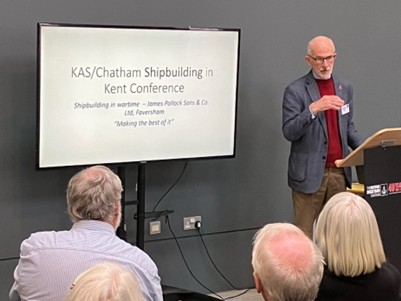
The second session before lunch on day two was chaired by Emma Ovenden on Maritime Resources and Research. David Patient’s presentation on ‘Ship and Boatbuilding at Gravesend in the Days of Sail and Oar’ laid a foundation for his forthcoming book on The Tilt Boats and Hatch boats of Gravesend and the London River, 1555-1865. A retired shipwright, David focussed on barges, primarily under oars, from the 13th century which served the ‘Long Ferry’, the passenger service between Gravesend and Billingsgate in the City of London. The Gravesend Corporation had barges built and ran the ferry before the vessels were superseded by the tilt boat under sail. The hatch boat, in the second half of the 18th century, was built at Gravesend to carry fresh fish from the town to Billingsgate Fish Market. Tilt boats, hatch boats, Naval warships, merchant ships, cod smacks, and passenger steamers were all launched at Gravesend from local yards. The development from barge to tilt boat, the demand for Naval ships, and the deep-sea fishing industry that sustained the hatch boat’s trade was discussed in its historical context.
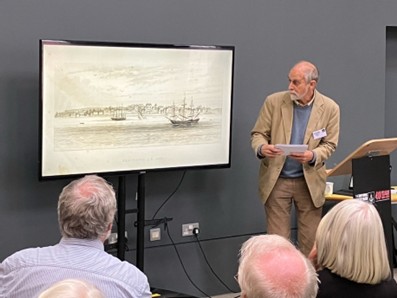
Alex Grover provided a history of the archives at the National Maritime Museum (NMM) at Greenwich. He excellently presented how the development and nurturing of the archives for both naval and merchant seafaring vessels ensured the saving of different collections from private collectors and curations from across the country. The NMM holds one of the largest technical drawing collections in the UK. The Admiralty collection is a near-unbroken run from the late 1600s to the 1970s and includes those ships built by royal and private yards within Kent over that period. The merchant collections not only include ships built in Kent from companies like Pollocks of Faversham, but also draughtsmen like Philip Oke who took the lines from vessels that operated in the county – at the time in danger of being broken up without a record. The Museum’s maritime photographic collection is large and varied and includes images of Kent as a place of work and play, putting the vessels built there into their cultural context.
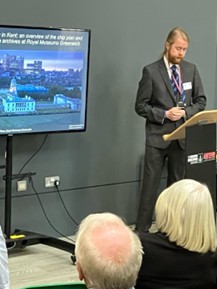
The final session after lunch on day two was entitled Shipbuilding at Chatham, chaired by Nick Ball. Dr Philip MacDougall provided a lively post-lunch talk on HMS Achilles – the first true iron-hulled battleship built in a naval dockyard. Achilles was one of a series of revolutionary new ships, proving that such vessels could be built in naval yards, rather than in the commercial yards that had adapted themselves to the building of large iron ships. The construction of Achilles resulted in a massive expansion scheme at Chatham, which once-again became the pre-eminent British naval dockyard. Philip outlined why Chatham was chosen for the building of Achilles, the changes that were necessary to undertake the task, and the problems which were overcome to ensure her construction. The resulting extension to Chatham Dockyard and the legacy of Achilles brought a massive increase in the size of the Yard’s workforce and transformed the towns of Chatham and Gillingham.
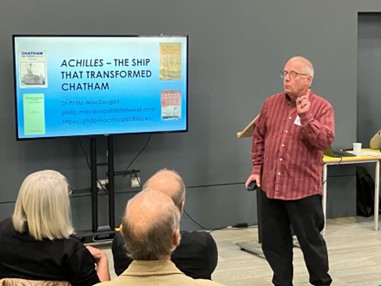
Next the penultimate speaker, Matthew Bellhouse Moran, spoke on HMS Unicorn. Launched in 1824, HMS Unicorn is the most original old ship in the world. Originally constructed as a 46-gun frigate at Chatham Royal Dockyard, Unicorn arrived in Dundee in 1873 as a training ship for the Royal Naval Reserves – a role she carried out until the 1960s. In preparation of the building of the Tay Road Bridge in 1962, the city’s Earl Grey Dock was to be filled in. As a result, HMS Unicorn’s 89-year berth was to be lost, and the Admiralty considered breaking up the ship.
In order to preserve the ship for future generations, Matthew explained how the Unicorn Preservation Society (UPS) was formed. HMS Unicorn is still moored on the city’s waterfront and is now the oldest ship left in Scotland, as well as one of the six oldest ships in the world. Matthew discussed the history of HMS Unicorn and the UPS, how the ship has been preserved into the 21st century, and the continuing work aimed at creating a sustainable future for the ship through Project Safe Haven.
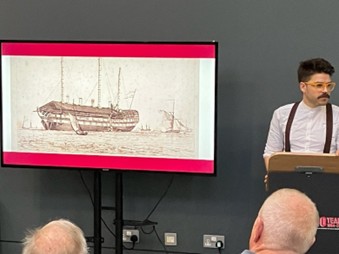
The final speaker of the conference was Jools Maxwell who spoke on the ‘London Wreck: Rediscovery and Excavation’. The London sank in 1665 off the Southend coast. The rediscovery and underwater archaeological excavation of the wreck have provided valuable insight into naval operations and everyday life onboard a 17th century warship. Jools explored the challenges of excavating a wreck site in a low visibility, highly tidal environment and examined some of the objects recovered – a well-received presentation by the audience.
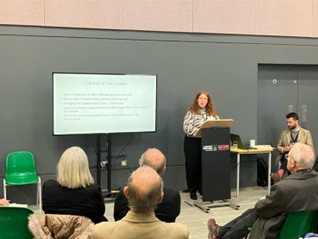
The steering group for the Maritime Kent Special Interest Group took audience questions at the end of the conference, and Stuart Bligh chaired closing remarks and a summary of the key points from the two-day event. With some thoughts and questions the group has plenty of planning to do for the next conference.
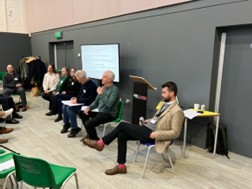
This was a highly successful and enjoyable inaugural Kent Maritime Conference which has manifested a county and national wide interest in shipbuilding and maritime social and cultural history. Well done to all involved and thank you to Chatham Historic Dockyard for being splendid hosts!
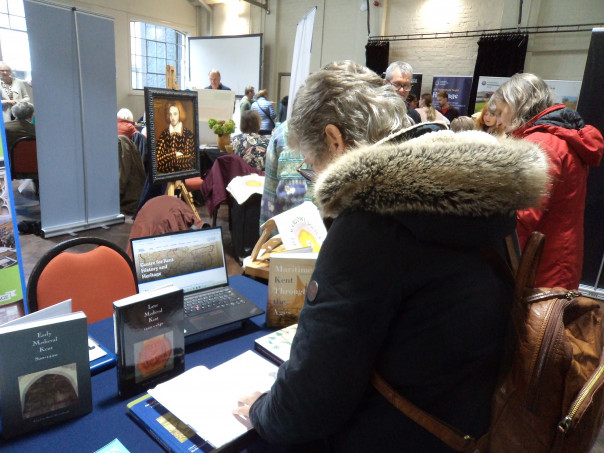
Now for something different, it was the Canterbury Expo on Saturday and among the stalls was CKHH showcasing books and articles written and edited by Centre staff as well as the new website. Nearby was Drs Robert Gallagher’s (University of Kent) and Heidi Stoner‘s (CCCU) stall with their new ‘Vikings in Kent’ project on which they also gave a presentation.
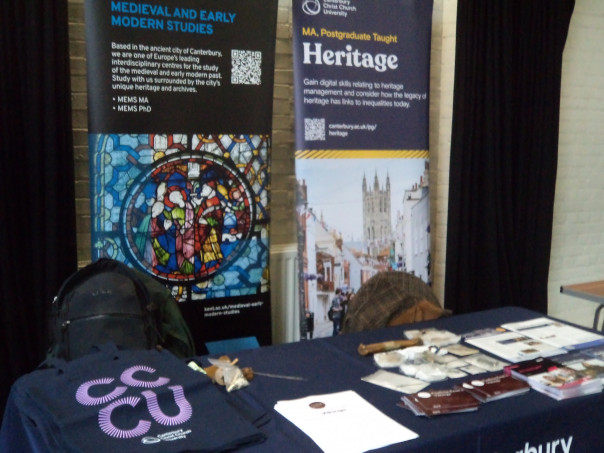
The Canterbury Expo, organised by the Canterbury Society, was following in the footsteps of the Kent History Showcase 2022: https://blogs.canterbury.ac.uk/kenthistory/mcw2022-and-kent-gateway-to-the-world-history-festival/ and the second such event at Dover Museum in 2023. Consequently it is great to see such events continuing in east Kent, thereby matching the series of very successful Medway History Showcase events that have been taking place at the Royal Engineers Museum at Gillingham, the latest was just over a month ago: https://blogs.canterbury.ac.uk/kenthistory/mhs-24-and-kas-historic-buildings-the-ckhh-out-and-about-in-kent/ – all of which having featured in the CKHH blog.
 Centre for Kent History and Heritage
Centre for Kent History and Heritage Sheila Sweetinburgh
Sheila Sweetinburgh 2115
2115

